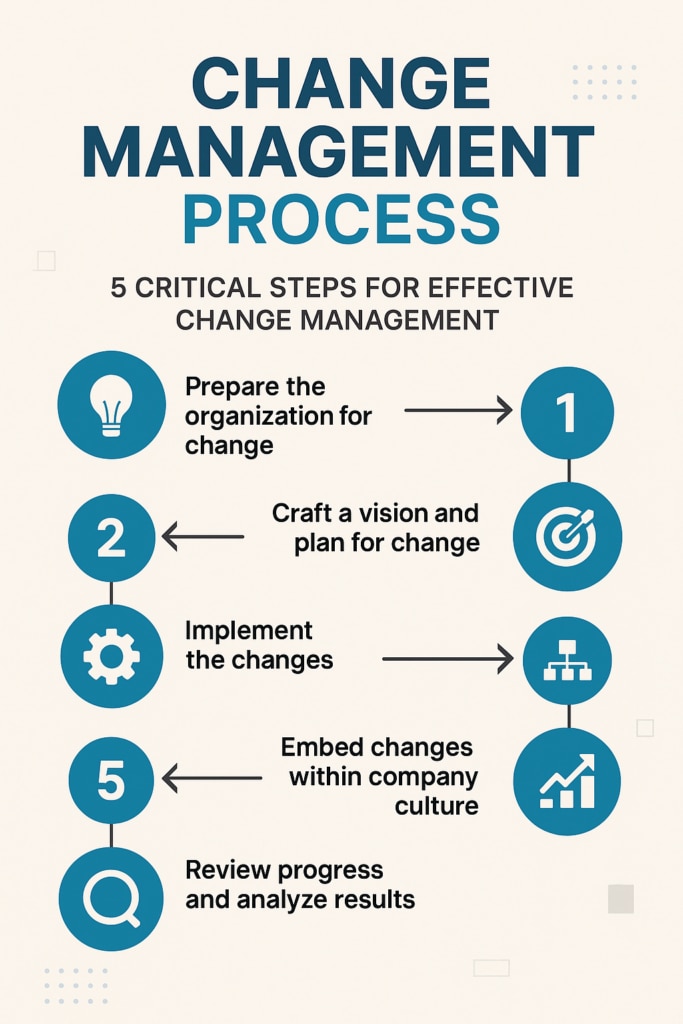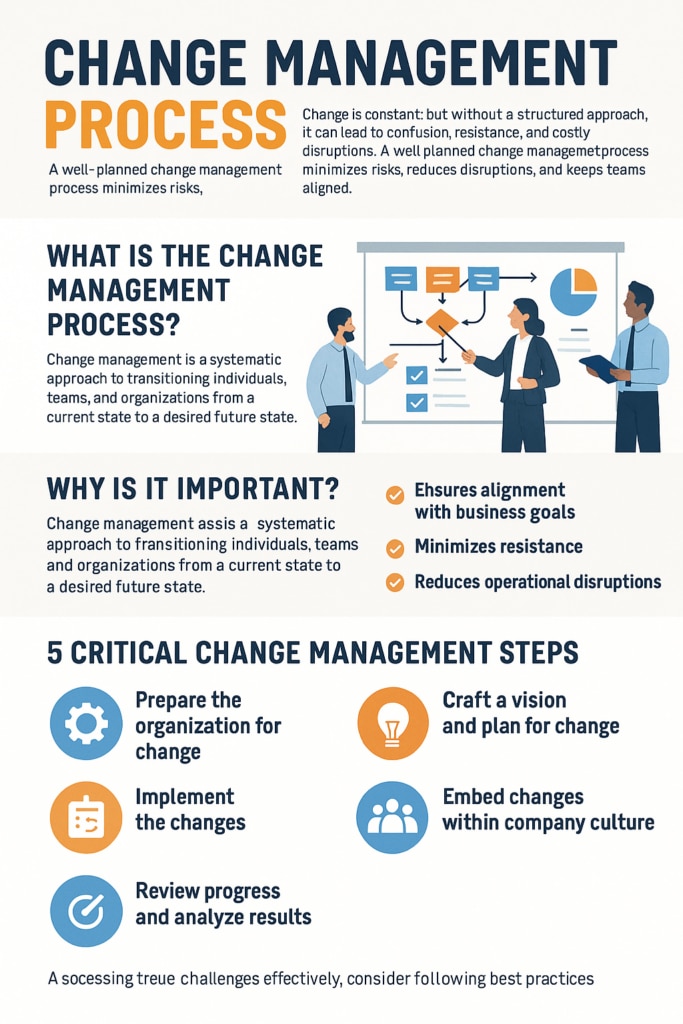Change is constant, but without a structured approach, it can lead to confusion, resistance, and costly disruptions. A well-planned change management process ensures transitions happen smoothly, minimizing risks while keeping teams aligned and operations running efficiently. Whether adopting new technology, restructuring teams, or refining business strategies, organizations that manage change effectively turn challenges into opportunities for growth.
What is the change management process?
Change management is a systematic approach to transitioning individuals, teams, and organizations from a current state to a desired future state. It involves preparing, supporting, and helping employees adapt to organizational changes to achieve business outcomes. This process encompasses methods that redirect or redefine the use of resources, business processes, budget allocations, or other modes of operation that significantly reshape a company or organization.
Why is the change management process so important?
Implementing change without proper management can lead to confusion, resistance, and failure to achieve desired outcomes. An effective change management process is crucial because it:
- Ensures alignment with business goals: Structured change initiatives keep the organization on track toward its objectives.
- Minimizes resistance: Engaging employees and addressing their concerns reduces pushback.
- Reduces operational disruptions: A clear plan ensures continuity during transitions.
- Enhances adaptability: Organizations become more agile in responding to market or environmental shifts.
5 critical change management steps for effective change management
A successful change management process typically includes the following steps:
- Prepare the organization for change
Assess the organization’s readiness and create awareness about the need for change. Engage stakeholders early to build support and address concerns. - Craft a vision and plan for change
Develop a clear vision that aligns with organizational goals. Create a strategic plan outlining objectives, timelines, resources, and metrics for success. - Implement the changes
Execute the plan by allocating resources, assigning responsibilities, and providing necessary training. Ensure open communication to address concerns and gather feedback. - Embed changes within company culture
Reinforce new behaviors and processes by integrating them into the organizational culture. Recognize and reward adaptability to encourage sustained change. - Review progress and analyze results
Monitor the outcomes of the change initiative against predefined metrics. Gather feedback, identify areas for improvement, and make necessary adjustments.

Challenges in the change management process
Organizations may encounter several challenges during change management, including:
- Employee resistance: Fear of the unknown or loss of job security can lead to pushback.
- Inadequate communication: Lack of clear information can cause confusion and mistrust.
- Insufficient resources: Limited time, budget, or personnel can hinder implementation.
- Cultural inertia: Deeply ingrained organizational cultures may resist new ways of working.
Read also: Change Management KPIs
Best practices for successful change management
To navigate these challenges effectively, consider the following best practices:
- Mobilize active and visible sponsorship: Ensure leaders are committed and visibly support the change.
- Apply a structured change management approach: Utilize proven methodologies to guide the process.
- Engage with front-line employees: Involve those affected by the change to gain insights and foster buy-in.
- Communicate frequently and openly: Maintain transparency to build trust and keep everyone informed.
- Engage and integrate with project management: Align change initiatives with project management practices for seamless execution.
- Dedicate change management resources: Assign specific roles or teams to oversee the change process.
- Engage with and support people managers: Equip managers with the tools to lead their teams through change.
- Utilize appropriate tools: Implement change management software, such as SolarWinds Service Desk, to streamline processes and enhance efficiency.
Key takeaways from a successful change management process
A well-executed change management process:
- Aligns change initiatives with strategic objectives.
- Engages stakeholders at all levels to foster support.
- Utilizes structured methodologies to navigate complexities.
- Maintains open communication to build trust and transparency.
- Leverages technology and tools to facilitate smooth transitions.
By adhering to these principles and steps, organizations can effectively manage change, ensuring resilience and continued success in a dynamic business environment.

What tools support the change management process flow?
The IT change management process flow can easily get out hand, especially with so many moving parts to track and so many stakeholders to communicate with. This means organizations need powerful IT tools capable of making sense of what can otherwise become a messy process. Ultimately, change management requires software capable of streamlining disparate ITIL steps, making it easy for everyone to weigh in on critical business decisions.
Personally, I like Web Help Desk and Service Desk from SolarWinds for my change management needs. Web Help Desk makes it easy to track work tickets for requested changes as they move through change management processes and even gives you convenient options for setting up CABs. With Service Desk, IT teams get a suite of IT change management capabilities to help with the deployment phase of change management and collect useful data for future changes. If you’re looking for change management support, you can’t go wrong with either of these tools from SolarWinds.
Read also: 15 Best Change Management Software for 2024

